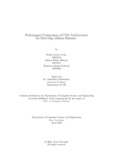| dc.contributor.advisor | Chakrabarty, Amitabha | |
| dc.contributor.author | Rinky, Habiba Karim | |
| dc.contributor.author | Bhuiyan, Rakeya Rahim | |
| dc.contributor.author | Rahman, Humayra Tasnim | |
| dc.date.accessioned | 2021-07-03T14:00:49Z | |
| dc.date.available | 2021-07-03T14:00:49Z | |
| dc.date.copyright | 2020 | |
| dc.date.issued | 2020-04 | |
| dc.identifier.other | ID 16101252 | |
| dc.identifier.other | ID 16101063 | |
| dc.identifier.other | ID 16101127 | |
| dc.identifier.uri | http://hdl.handle.net/10361/14725 | |
| dc.description | This thesis is submitted in partial fulfillment of the requirements for the degree of Bachelor of Science in Computer Science and Engineering, 2020. | en_US |
| dc.description | Cataloged from PDF version of thesis. | |
| dc.description | Includes bibliographical references (pages 38-39). | |
| dc.description.abstract | World is facing an acute health crisis for the disease named malaria caused by the bite
of female mosquitoes of parasite named genus plasmodium. From different research
of all time it is clear that this disease is not confined within a certain specific region
or area rather this infection is common all over the world. Many researchers from
all over the globe discovered many processes or techniques to determine malaria
infection from host body. Malaria Detection consumes huge time to detect. This
study aims to determine the infected malaria cells using deep learning algorithms
as it is important part in this advanced technological era to determine objects.
This research used deep learning algorithms like VGG-16, VGG-19, VGG-16 binary,
VGG-19 binary, Alexnet, MobileNet, ResNet34, ResNet50 and CNN2D to determine
malaria infected cells from images. Thereby, also finds the comparative analysis
between these algorithms to determine the best accuracy giving algorithm. From
the study it is evident that algorithms named AlexNet, VGG-16, VGG-19, VGG-
16 binary, VGG-19 binary, MobileNet, CNN2D, ResNet34 and ResNet50 give an
accuracy of 94.84%, 92%, 92%, 97.4%, 96.53%, 95.42%, 96.91%, 97.06% and 85%
respectively. From the comparative analysis between these nine algorithms, this
study concludes to and ResNet34 with model accuracy 97.06% as the best accuracy
giving algorithm. | en_US |
| dc.description.statementofresponsibility | Habiba Karim Rinky | |
| dc.description.statementofresponsibility | Rakeya Rahim Bhuiyan | |
| dc.description.statementofresponsibility | Humayra Tasnim Rahman | |
| dc.format.extent | 39 pages | |
| dc.language.iso | en | en_US |
| dc.publisher | Brac University | en_US |
| dc.rights | Brac University theses are protected by copyright. They may be viewed from this source for any purpose, but reproduction or distribution in any format is prohibited without written permission. | |
| dc.subject | Malaria | en_US |
| dc.subject | Plasmodium falciparum | en_US |
| dc.subject | Plasmodium vivax | en_US |
| dc.subject | Plasmodium malaria | en_US |
| dc.subject | Plasmodium ovale | en_US |
| dc.subject.lcsh | Deep learning | |
| dc.title | Performance comparison of CNN architectures for detecting Malaria diseases | en_US |
| dc.type | Thesis | en_US |
| dc.contributor.department | Department of Computer Science and Engineering, Brac University | |
| dc.description.degree | B. Computer Science | |

